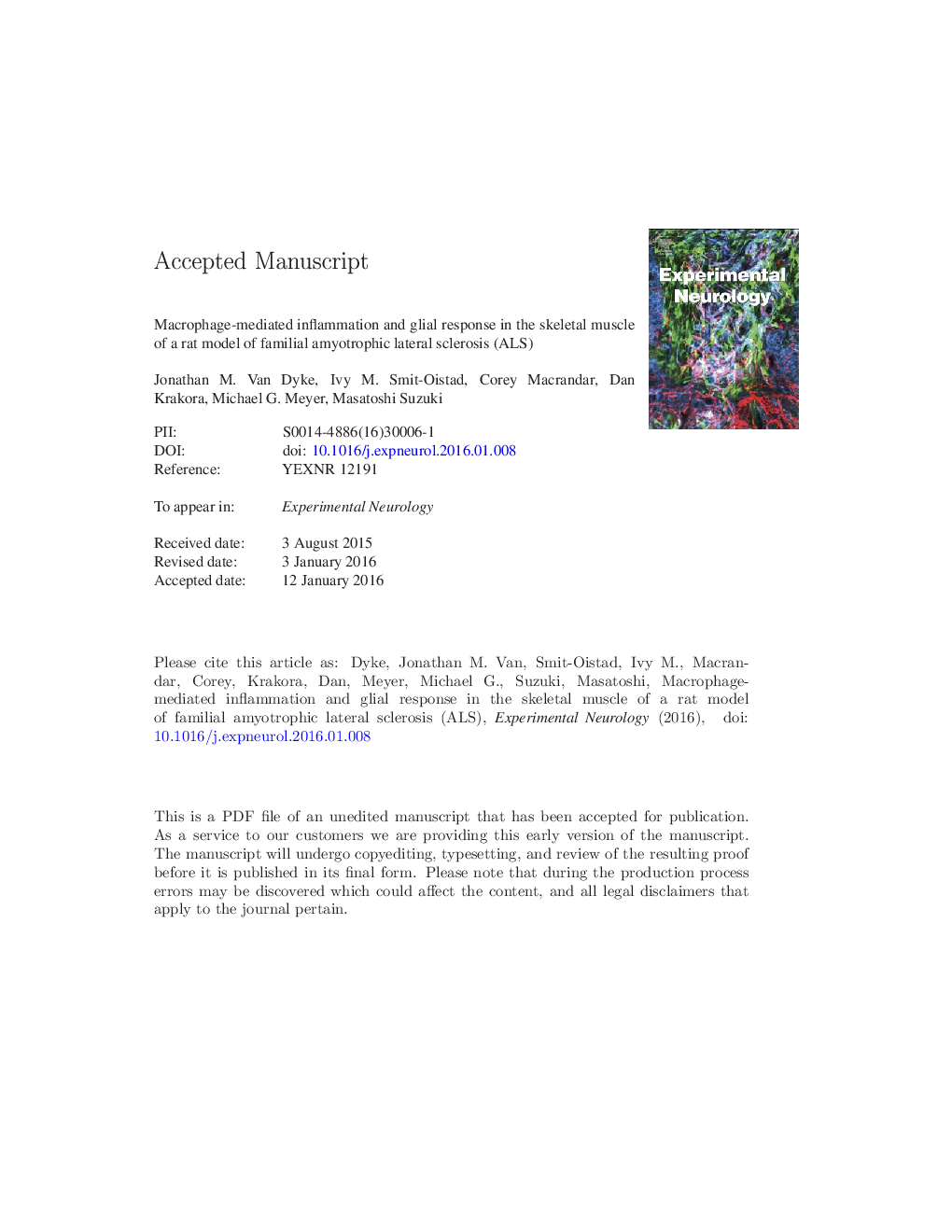| Article ID | Journal | Published Year | Pages | File Type |
|---|---|---|---|---|
| 6017172 | Experimental Neurology | 2016 | 32 Pages |
Abstract
Amyotrophic lateral sclerosis (ALS) is a fatal neurodegenerative disease characterized by progressive motor dysfunction and loss of large motor neurons in the spinal cord and brain stem. While much research has focused on mechanisms of motor neuron cell death in the spinal cord, degenerative processes in skeletal muscle and neuromuscular junctions (NMJs) are also observed early in disease development. Although recent studies support the potential therapeutic benefits of targeting the skeletal muscle in ALS, relatively little is known about inflammation and glial responses in skeletal muscle and near NMJs, or how these responses contribute to motor neuron survival, neuromuscular innervation, or motor dysfunction in ALS. We recently showed that human mesenchymal stem cells modified to release glial cell line-derived neurotrophic factor (hMSC-GDNF) extend survival and protect NMJs and motor neurons in SOD1G93A rats when delivered to limb muscles. In this study, we evaluate inflammatory and glial responses near NMJs in the limb muscle collected from a rat model of familial ALS (SOD1G93A transgenic rats) during disease progression and following hMSC-GDNF transplantation. Muscle samples were collected from pre-symptomatic, symptomatic, and end-stage animals. A significant increase in the expression of microglial inflammatory markers (CD11b and CD68) occurred in the skeletal muscle of symptomatic and end-stage SOD1G93A rats. Inflammation was confirmed by ELISA for inflammatory cytokines interleukin-1 β (IL-1β) and tumor necrosis factor-α (TNF-α) in muscle homogenates of SOD1G93A rats. Next, we observed active glial responses in the muscle of SOD1G93A rats, specifically near intramuscular axons and NMJs. Interestingly, strong expression of activated glial markers, glial fibrillary acidic protein (GFAP) and nestin, was observed in the areas adjacent to NMJs. Finally, we determined whether ex vivo trophic factor delivery influences inflammation and terminal Schwann cell (TSC) response during ALS. We found that intramuscular transplantation of hMSC-GDNF tended to exhibit less inflammation and significantly maintained TSC association with NMJs. Understanding cellular responses near NMJs is important to identify suitable cellular and molecular targets for novel treatment of ALS and other neuromuscular diseases.
Keywords
CD68AChRGDNFalpha-bungarotoxinα-BTXC9orf72CD11Bcluster of differentiation 11bGAPDHEGTAGFAPGFRα1BVCBupivacaine hydrochlorideEDTAethylene glycol tetraacetic acidEthylenediaminetetraacetic acidamyotrophic lateral sclerosisALSanalysis of varianceANOVAEnzyme-linked immunosorbent assayELISACluster of differentiation 68BBBGlial cell line-derived neurotrophic factorGlial fibrillary acidic proteinchromosome 9 open reading frame 72glyceraldehyde-3-phosphate dehydrogenaseacetylcholine receptor
Related Topics
Life Sciences
Neuroscience
Neurology
Authors
Jonathan M. Van Dyke, Ivy M. Smit-Oistad, Corey Macrander, Dan Krakora, Michael G. Meyer, Masatoshi Suzuki,
